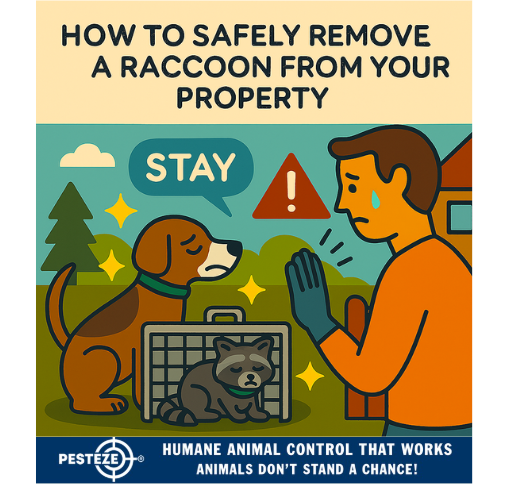HOW TO SAFELY REMOVE A RACCOON FROM YOUR PROPERTY

HOW TO SAFELY REMOVE A RACCOON FROM YOUR PROPERTY
SUMMARY
Raccoons may look cute, but they can cause serious damage to your home and pose health risks if not handled properly. Whether they’re rummaging through trash, nesting in attics, or raiding gardens, it’s important to remove them safely and legally. This guide outlines humane and effective strategies for deterring and removing raccoons from your property, while staying compliant with local wildlife laws. With the right approach, you can protect your home and avoid unnecessary harm.
FEATURES
-
Identify Signs of Raccoon Activity: Look for tipped trash cans, paw prints, nesting materials, or nighttime noises.
-
Remove Food and Shelter Sources: Secure garbage bins, pet food, and access points to attics or crawl spaces.
-
Use Humane Deterrents: Motion-activated lights, sprinklers, and scent repellents can discourage raccoons.
-
Avoid Direct Confrontation: Never attempt to corner or touch a raccoon, especially if it appears sick or aggressive.
-
Contact Wildlife Control Professionals: Licensed experts can safely trap and relocate raccoons according to local laws.
-
Seal Entry Points After Removal: Close off holes, vents, and gaps to prevent future infestations.
GUIDE DESCRIPTION
Raccoons are highly adaptable and intelligent animals that often find their way into residential areas in search of food and shelter. While they play a role in the ecosystem, their presence on your property can lead to damage, disease transmission, and unwanted encounters with pets or children.
Start by identifying signs of raccoon activity. Common indicators include overturned trash cans, scattered food, paw prints, droppings, and scratching noises—especially at night. If you suspect a raccoon is nesting in your attic or crawl space, act quickly.
Remove attractants from your property. Secure garbage bins with locking lids, bring pet food indoors, and eliminate standing water. Trim tree branches that provide easy access to roofs and seal off potential entry points like vents, chimneys, and loose siding.
Humane deterrents are effective and safe. Motion-activated lights or sprinklers can startle raccoons and discourage repeat visits. Scent repellents like ammonia-soaked rags or commercial raccoon repellents may also help.
Never attempt to handle a raccoon yourself. These animals can carry rabies and other diseases, and may become aggressive if threatened. If a raccoon appears sick, injured, or refuses to leave, contact a licensed wildlife control professional. They can assess the situation and remove the animal in compliance with local regulations.
Once the raccoon is removed, seal all entry points to prevent future intrusions. Use durable materials like metal mesh or hardware cloth to block vents and gaps. Regularly inspect your property for signs of re-entry.
By following these steps, you’ll ensure a safe, humane, and effective removal process that protects both your home and local wildlife.
- Amy Chang


Comments 0